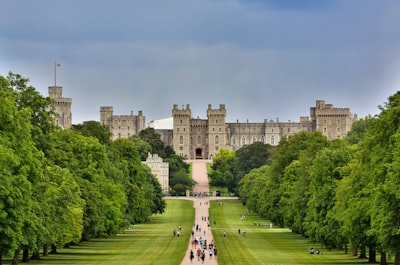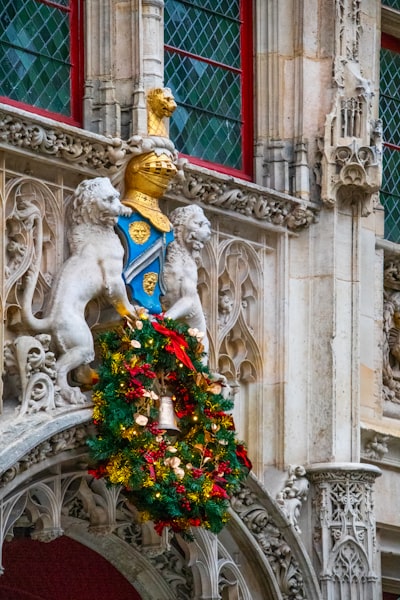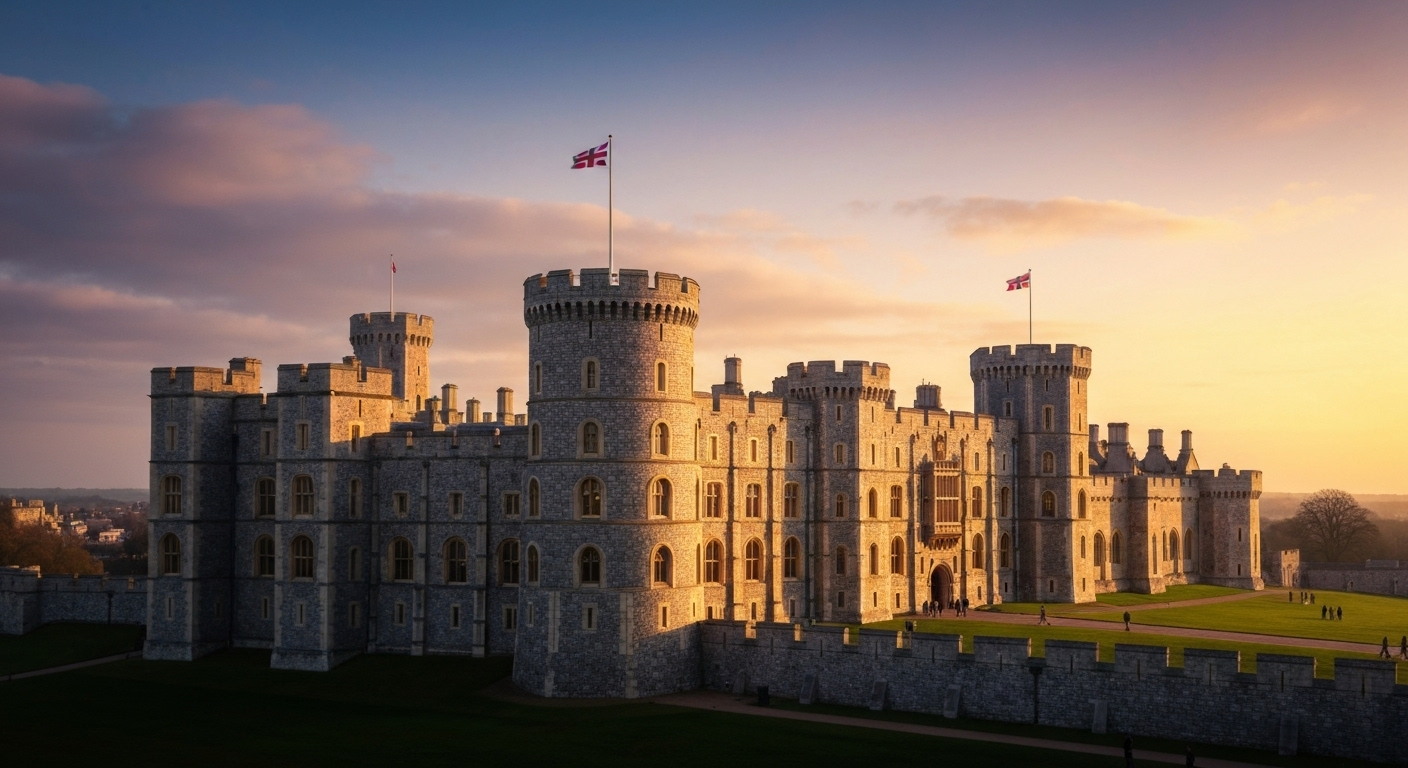Key Highlights
- Discover the history of Windsor Castle, the largest occupied castle in the world.
- The castle has served as a royal residence for the British royal family for nearly 1,000 years.
- Explore the magnificent State Apartments, home to priceless works of art from the Royal Collection.
- Learn about pivotal moments in its history, from the English Civil War to a devastating fire in 1992.
- Find out how the castle functions today as both a home for the monarch and a major tourist attraction.
Introduction
Welcome to Windsor Castle, a landmark that stands as a powerful symbol of the British monarchy. For almost a millennium, this magnificent fortress has been intertwined with the story of the royal family. It is not just a historic monument but a living, breathing home that has witnessed centuries of change. Are you ready to explore the incredible history of Windsor Castle? This journey will take you through its origins, transformations, and enduring legacy as one of the most famous royal residences in the world.
The Majesty of England’s Largest Occupied Castle
Windsor Castle’s title as the largest occupied castle in the world is a testament to its grandeur and continuous importance. It has served as a royal residence for 40 monarchs, making it the oldest continuously inhabited castle globally. This long history of occupation is what sets it apart from many other historic fortresses.
Inside its walls, you’ll find an astonishing collection of works of art and lavish interiors that reflect its rich past. The castle is not merely a museum; it remains a key home for the British royal family. Let's look at what makes it so vast and where it is situated.
What Makes Windsor Castle the Largest Inhabited Castle
So, what exactly gives Windsor Castle its status as the largest occupied castle? The answer lies in its sheer scale and unbroken history of royal use. Spanning over 13 acres, the castle comprises numerous buildings, including private apartments, grand state rooms, and the iconic St. George's Chapel.
Unlike many castles that have fallen into ruin or become purely museums, Windsor has been a functioning royal residence for nearly 1,000 years. This continuous line of residents, from William the Conqueror to modern monarchs like Queen Elizabeth II, makes it the oldest and largest inhabited castle. It has been the cherished home of the royal family, adapting through centuries to meet their needs.
Today, around 150 people call the castle home, ensuring its smooth operation as a working palace. This combination of size, historical continuity, and its role as an active royal residence solidifies its unique title.
Where Windsor Castle Stands on the English Landscape
You can find Windsor Castle perched in the county of Berkshire, within the charming town of Windsor. Its strategic location on a hill offers commanding views of the surrounding area and the nearby River Thames. This spot was originally chosen by William the Conqueror for its defensive advantages, as it was part of a ring of fortifications around London.
The castle is about 20 miles west of central London, making it an accessible and popular day trip from the capital. Across the river lies the famous college town of Eton, adding to the historic atmosphere of the region. The castle grounds also connect to the expansive Windsor Great Park, a former royal hunting ground.
Getting there is straightforward. You can take a direct train from London Waterloo to the Windsor & Eton Riverside station, which is just a short walk from the castle entrance. This convenient access allows thousands of visitors to experience its majesty each year.
A Journey Through Windsor Castle’s History
The history of Windsor Castle is a captivating story that begins in the 11th century. Originally a wooden fortress built by William the Conqueror, it has evolved dramatically over the centuries. Monarchs like King Henry II transformed it from a defensive stronghold into a fortified stone palace during the medieval period.
Each era left its mark, turning the castle into the architectural masterpiece you see today. We will now look at its royal beginnings and some of the most important events that have shaped its past.
Royal Beginnings and Founding Monarchs
The story of the original castle starts around 1070 with William the Conqueror. He constructed a motte-and-bailey fortress as part of a defensive ring to protect London. This early structure was made of timber and strategically positioned near the River Thames and royal hunting forests.
It was King Henry I, one of the key founding monarchs, who first used the castle as a royal residence around 1110. This set a precedent for centuries to come. However, it was during the 12th century under King Henry II that the castle underwent a major transformation. He began replacing the timber structures with stone, reinforcing its defenses and creating the foundation of the castle we know today.
This included rebuilding the original keep into the stone Round Tower, an iconic feature that still stands at the center of the castle grounds. These early changes marked the beginning of Windsor's evolution from a simple fortress to a grand royal palace.
Noteworthy Historical Events at Windsor Castle
Windsor Castle has been at the center of many significant moments in British history. During the 17th-century English Civil War, it was seized by Parliamentary forces and used as a military headquarters and prison. After the Restoration of the Monarchy, Charles II transformed it with lavish baroque interiors.
The castle also served as a safe haven for the royal family during World War II, with its precious art collection moved there for protection. More recently, in 1992, a catastrophic fire destroyed over 100 rooms, leading to a massive five-year restoration project.
Beyond these pivotal moments, the castle has witnessed countless royal ceremonies and occasions. Some of the most noteworthy historical events include:
- The establishment of the Order of the Garter by Edward III in the 14th century.
- The castle withstanding a prolonged siege during the First Barons' War.
- Serving as a refuge for Queen Elizabeth I during times of plague.
- Hosting the wedding of Prince Harry and Meghan Markle in 2018.
Architectural Splendor: Exploring the Castle’s Structure

The architecture of Windsor Castle is a stunning tapestry of different historical styles, from Norman defenses to a grand Gothic palace. Its impressive structure tells the story of its evolution over nearly 1,000 years. Prominent features like the formidable Round Tower showcase its medieval military origins.
Inside, the lavish State Apartments and royal apartments reveal a history of opulence and artistic patronage. The magnificent state rooms were designed to impress visitors and host grand occasions. Let's take a closer look at the castle's iconic defensive features and its breathtaking interiors.
The Iconic Round Tower and Defensive Features
The Round Tower is arguably the most recognizable feature of Windsor Castle's skyline. It stands on a man-made mound, or "motte," which was part of the original defensive features from the medieval period. This elevated position provided a clear vantage point for spotting approaching enemies.
Initially built from timber by William the Conqueror, the tower was rebuilt in stone by Henry II in the 12th century. This upgrade significantly strengthened the castle structure and its defenses, helping it withstand a long siege during the First Barons' War. The tower you see today was further heightened in the 19th century under George IV to create a more dramatic silhouette.
Interestingly, the Round Tower is not perfectly circular; it has a straight side to the south. It serves as a powerful symbol of the castle's enduring strength and historical continuity, linking its past as a fortress to its present as a palace.
The State Apartments and Grand Interiors
Moving inside, the State Apartments are a breathtaking display of royal grandeur. These ceremonial rooms were created by King Charles II to rival the splendor of the Palace of Versailles. They are used today for official functions, including hosting visiting heads of state for state banquets.
The rooms are adorned with priceless works of art from the Royal Collection Trust, including paintings by masters like Rembrandt and Leonardo da Vinci, exquisite tapestries, and fine furniture. Following the 1992 fire, many rooms were meticulously restored to their former glory, while others were redesigned for the modern era.
When you visit, you can walk through these incredible spaces. Highlights of the grand interiors include:
- The Grand Reception Room, with its dazzling chandeliers and gold-covered walls.
- St. George's Hall, a vast hall celebrating the Order of the Garter.
- The Crimson Drawing Room, one of the rooms beautifully restored after the fire.
Life at Windsor Castle Today
Windsor Castle is far more than just a historical monument; it is a place of living history. It continues its centuries-old role as an official royal residence and a working palace. The late Queen Elizabeth II famously considered it her favorite weekend home, and it remains central to the royal family.
The castle seamlessly blends its historic past with modern life, hosting important ceremonies and state events throughout the year. Let's explore its current role as a home for the monarch and the vibrant traditions that keep its history alive.
The Castle’s Role as an Active Royal Residence
Windsor Castle proudly holds its status as a working royal residence, a tradition upheld by British monarchs for nearly a millennium. The late Queen Elizabeth II spent many of her private weekends at the castle, as well as a month over Easter. This personal connection makes it a true home, not just a state building.
Do you wonder who currently lives in Windsor Castle? While the reigning monarch uses it as an official residence, the castle is also home to a community of around 150 people who work and live within its walls. This includes the Constable and Governor of Windsor Castle, as well as many household staff who support the royal family and maintain the estate.
The castle continues to host significant royal events, from private family gatherings to major public ceremonies like the wedding of Prince Harry and Meghan Markle. Its role as an active home ensures that its history is constantly evolving.
Living History—Ceremonies, Traditions, and Modern Use

The castle's role as a center for living history is most evident in its many ceremonies and traditions. These events connect the present-day monarchy to centuries of history, and many are open for the public to witness. How is Windsor Castle still used as an official royal residence today? The answer is through these vibrant traditions.
The Changing of the Guard is one of the most famous ceremonies, where soldiers in iconic red tunics and bearskin hats perform a formal handover of duties. This colorful spectacle marches through the town of Windsor and into the castle grounds, attracting crowds of onlookers.
In addition to daily ceremonies, the castle hosts major annual events and state functions. These traditions include:
- The Order of the Garter service, where the monarch installs new knights in St. George's Chapel.
- Hosting state visits for world leaders and foreign dignitaries.
- Serving as the final resting place for many monarchs, including Queen Elizabeth II.
Visiting Windsor Castle: Experience and Highlights
A visit to Windsor Castle offers an unforgettable visitor experience, allowing you to step directly into the world of British royalty. A castle tour reveals centuries of history, magnificent architecture, and stunning art. There are numerous must-see attractions to explore, from the grand State Apartments to the hallowed halls of St. George's Chapel.
Planning your trip is easy, with options like the Green Line bus from London providing a scenic route. To help you make the most of your day, we will cover the top rooms to see and offer some practical tips for your visit.
Must-See Rooms and Attractions for Visitors
What can visitors see and do inside Windsor Castle? A tour offers a wealth of incredible sights. Your journey begins in the castle precincts, where you can join a 30-minute guided tour to learn about the exterior architecture and history.
Inside, the State Rooms are a definite highlight, showcasing lavish decorations and masterpieces from the Royal Collection. Don't miss Queen Mary's Dolls' House, an astonishingly detailed miniature palace built in the 1920s. You can also explore St. George's Chapel, a stunning example of Gothic architecture and the burial place of 11 monarchs.
For an unforgettable experience, make sure these attractions are on your list:
- St. George's Hall, a magnificent room that seats 160 guests for state banquets.
- The Great Kitchen, the oldest working kitchen in England, which has served 32 monarchs.
- Queen Mary's Dolls' House, complete with running water and electricity.
- A walk along the famous Long Walk for a picture-perfect view of the castle.
Tips for Planning Your Windsor Castle Tour
Is Windsor Castle open to the public for tours? Yes, it welcomes visitors throughout the year, but careful visit planning will enhance your experience. It's highly recommended to book your tickets online in advance. This not only secures your spot but often comes at a reduced price compared to buying on the day.
The castle is typically open Thursday to Monday but is closed on Tuesdays and Wednesdays. Since it is a working royal palace, closures can happen at short notice for state ceremonies or other events, so always check the official website before you travel. Allow at least two to three hours for your visit to see everything without rushing.
To make your castle tour as smooth as possible, keep these tips in mind:
- Arrive early to pass through the airport-style security.
- Use the complimentary multimedia guide to learn about the history of each room.
- Photography is permitted in the outside areas but not inside the State Apartments or St. George's Chapel.
- Travel in by train or use the Green Line bus to avoid parking hassles.
Windsor Castle Compared with Other English Castles
How does Windsor Castle compare to other castles in England? While the country is home to many historic fortresses, Windsor stands in a class of its own. Its dual role as a fortress and a continuous royal residence for nearly 1,000 years gives it a unique cultural legacy. It is not a ruin but a living, working palace.
Many other English castles are now picturesque ruins or museums, but Windsor's status as the largest occupied castle in the world sets it apart. Its age, size, and connection to the monarchy are unparalleled.
Size, Age, and Cultural Legacy Among British Castles
When comparing Windsor Castle to other British castles, its size, age, and cultural legacy are truly exceptional. Founded in the 11th century, it is one of the oldest, and its continuous use by the monarchy gives it a living history that few other sites can claim. Monarchs like King Edward III, George III, and Queen Victoria all made significant additions, shaping its grand appearance.
This unbroken chain of royal patronage has filled the castle with an unparalleled collection of art and treasures, cementing a cultural legacy that reflects a millennium of British history. While other castles may be older or have seen significant battles, none combine age, scale, and continuous occupation in the same way.
Conclusion
Windsor Castle stands as a testament to England's rich history and enduring royal traditions. As the largest occupied castle in the country, it offers visitors a unique glimpse into the past while serving as a vibrant royal residence today. From its architectural splendor to the captivating tales of its historical events, every corner of the castle echoes stories that have shaped the monarchy. Whether you're exploring the magnificent State Apartments or enjoying the serene gardens, Windsor Castle is a place where history comes alive. Plan your visit to discover its wonders for yourself—it's an experience you won't want to miss! For personalized tips on making the most of your trip, don’t hesitate to reach out for assistance.





